PR
X
Keyword Search
▼キーワード検索
Comments
私はイスラム教徒です@ Re:アイルランド・ロンドンへの旅(その131): ロンドン散策記・アルバート記念碑(Albert Memorial)-2(11/06)
神神は言った: コーランで 『 (21) 人々…
私はイスラム教徒です@ Re:アイルランド・ロンドンへの旅(その122): ロンドン散策記・Victoria and Albert Museum・ヴィクトリア&アルバート博物館-5(10/28)
神神は言った: コーランで 『 (21) 人…
2025年版・岡山大学…
 New!
隠居人はせじぃさん
New!
隠居人はせじぃさん
【時間が出来れば、… New!
Gママさん
New!
Gママさん
続日本100名城東北の… New! オジン0523さん
ムベの実を開くコツ… noahnoahnoahさん
noahnoahnoahさん
エコハウスにようこそ ecologicianさん
 New!
隠居人はせじぃさん
New!
隠居人はせじぃさん【時間が出来れば、…
 New!
Gママさん
New!
Gママさん続日本100名城東北の… New! オジン0523さん
ムベの実を開くコツ…
 noahnoahnoahさん
noahnoahnoahさんエコハウスにようこそ ecologicianさん
Calendar
カテゴリ: 海外旅行
【 海外旅行 ブログリスト
】👈️リンク
ヴィクトリア&アルバート博物館(V&A, ロンドン) の
Medieval & Renaissance 1350–1600 ギャラリー 👈️リンクを進む。
1.中央手前の噴水
・八角形の基壇を持つ噴水(well head)。
イタリア・ルネサンス期の庭園や邸宅に設置されていたもので、展示室のシンボル的存在。
2.中央奥の二体の彫像
・それぞれルネサンス期の大理石像やブロンズ像(例:「サムソン」や「プロセルピナの略奪」
など)と同系列の展示。人間の動きや肉体美を強調。
3.奥に見える黒い大きな構造物
・これは Tomb of Gaston de Foix(ガストン・ド・フォワの墓:1512頃) の複製です。
元はイタリア・ミラノのサンティ・マルチェリーノ・エ・ピエトロ教会に計画された
壮大な墓廟。
実際には未完成でしたが、そのデザインが後世に伝わり、V&A では黒い石膏モデルとして
展示されていた。
4.右手壁面の大きな枠付き彫刻
・聖母子像やキリスト磔刑を伴う宗教的浮彫(ルネサンス期の教会装飾から移されたもの)。
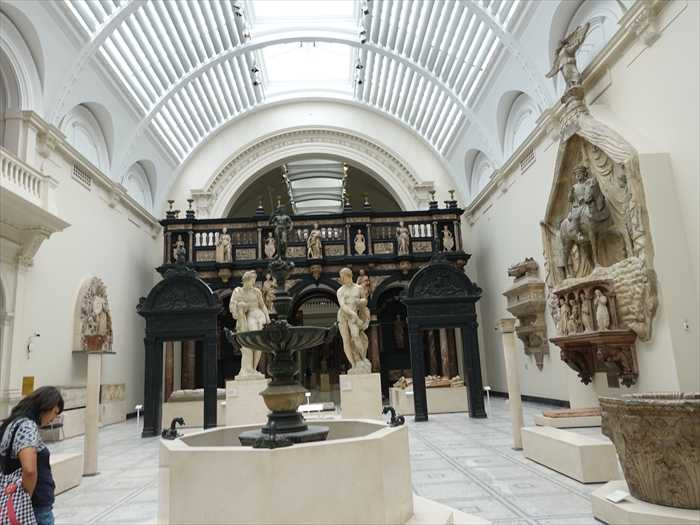
・左側(男性像):
→ 「 Zephyr(ゼピュロス) 」とされるもの。ギリシア神話において「西風の神」で、
男性の神格。展示されている像も、筋肉質な男性の裸体像として表現されていて、足元に小さな
裸体で、左に布を垂らし、足元にイルカのような海のモチーフが彫られているのが特徴。
・右側(男性像):
→ 「 アポロ像(Apollo) 」と考えられる像。腕に子供(小さな人物=キューピッドや音楽的
属性を持つ存在)を抱えているように見えます。これらはどちらも ルネサンス期イタリアの
神話主題彫刻 で、理想化された人体美を示す代表的な作例として並べて展示されていた。
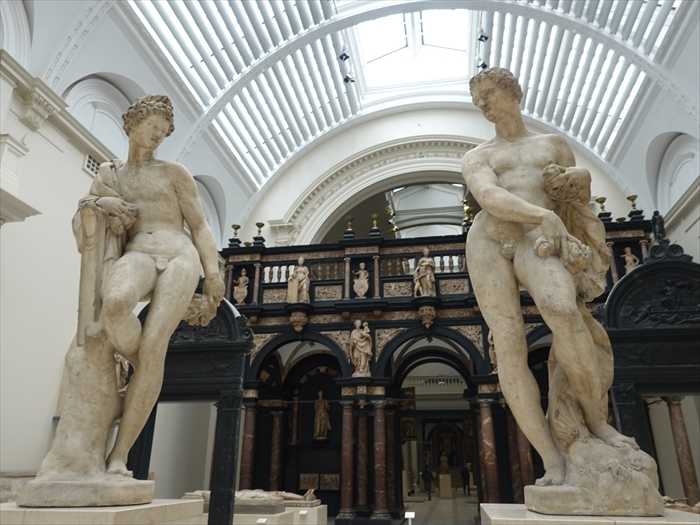
ZEPHYR
1576
Pietro Francavilla (1548–1615)
【 ゼピュロス(西風の神)
近くにあるアポロ像と共に、これは自然に関連する古代ローマの神々やニンフを表した13体の
彫刻シリーズの一つです。ゼピュロスは西風の神で、春や花を想起させる存在でした。
足元に彫られた息を吹きかけるケルブ(天使像)によって識別されます。
イタリア、フィレンツェ
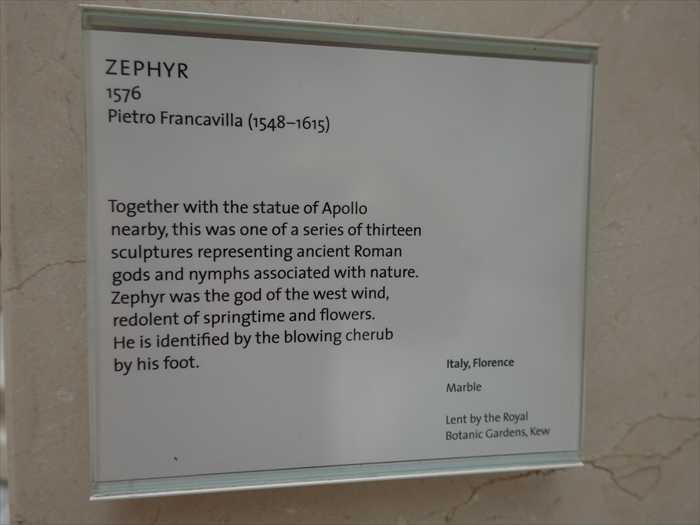
騎馬像を中心とする大きな壁龕彫刻(レリーフ)。
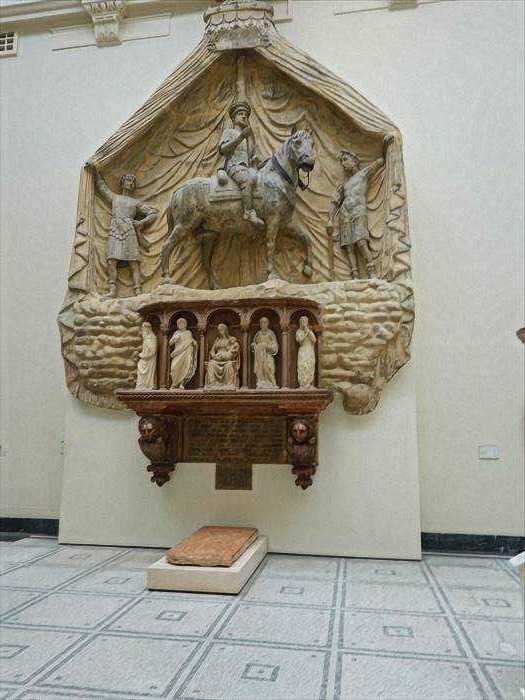
ズームして。
上段は the Monument Of Marchese Spinetta Malaspina(マルケーゼ・スピネッタ・
マラスピーナ記念碑) であると。
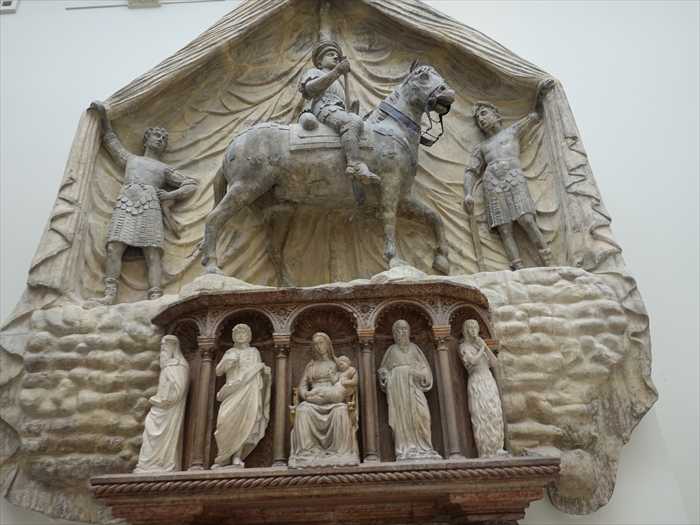
下段 をズームして。 聖母子と聖人像の小祭壇的群像(Tabernacle / Altarpiece fragments)

V&Aキャスト・コートの全景。V&Aキャスト・コートは世界の有名な彫刻作品のレプリカだけを
収めた部屋。

サン・フェリーチェ教会の内陣仕切り(Tramezzo / Choir Screen)。

・オリジナル所在地:
イタリア・ボローニャの San Petronio Basilica(サン・ペトロニオ聖堂) 、
またはフィレンツェの San Lorenzo(サン・ロレンツォ聖堂) の内陣仕切りと同系統の作品。
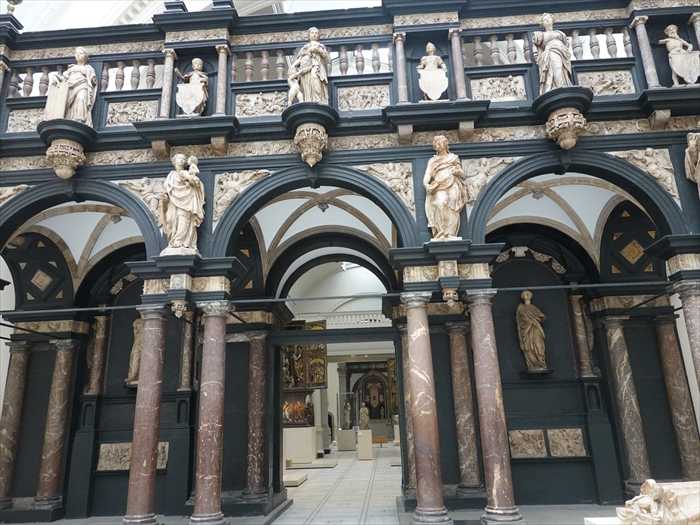
手前の
石棺(tomb effigies/墓碑像) 。
鎧姿で剣を持ち、手を合わせて祈る姿で横たわる「騎士の墓碑像」。
サンティアゴ騎士団の騎士 ドン・ガルシア・デ・オソリオ(1505–1509没)の墓碑像
(アルバスター製)奥にもう一体あったのは「 妻の墓碑像 」

移動して。

さらに

「 EFFIGY OF DON GARCÍA DE OSORIO
【 ガルシア・デ・オソリオの墓碑像
「 SIGNS AND SYMBOLS
The cross on the left breast of Don García de Osorio’s cloak shows that he belonged
to the Order of Santiago, a combined military and religious order dedicated toSt James
and founded in the 12th century. The lowest arm of the cross resembles a sword blade
and reflects the dual nature of the Order.」
【 ガルシア・デ・オソリオの墓碑像
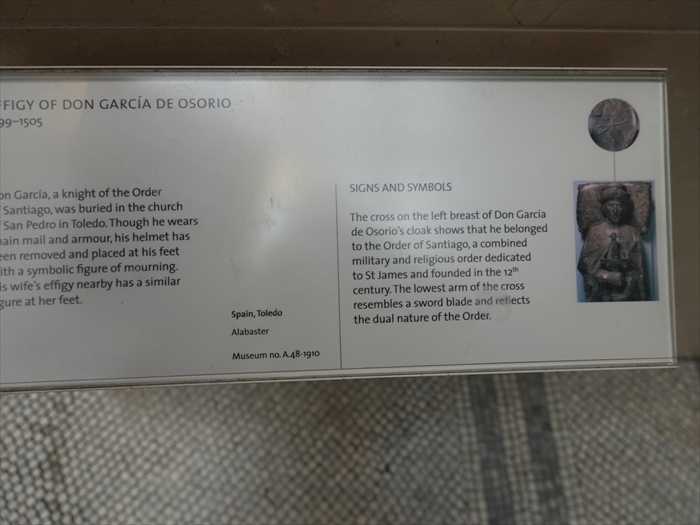
反対側・左側の墓碑像 。
・左側(手前)の棺 → 女性像(長衣をまとい、胸の上で両手を組む姿)。
・右側(奥)の棺 → 男性像(甲冑姿で剣を抱えた典型的な騎士像)。
「 Virgin of the Misericordia(慈悲の聖母) 」。
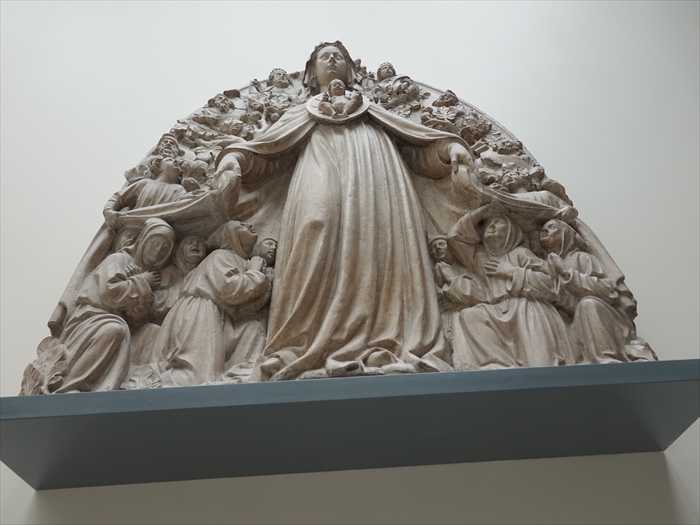
「 VIRGIN OF THE MISERICORDIA
Italy, Venice
SIGNS AND SYMBOLS
The mandorla (from the Italian word for ‘almond’) was a type of halo that enclosed
the entire body. It was usually used to depict moments that transcended time and
space, such as Christ enthroned in Heaven in majesty. Here the mandorla forms a
morse, or brooch, to clasp the Virgin's cloak.」
【 憐みの聖母(ヴィルジン・オブ・ザ・ミゼリコルディア)
制作地:イタリア、ヴェネツィア
記号と象徴
マンドルラ(イタリア語で「アーモンド」を意味)は、身体全体を囲む光背の一種でした。
通常、時間や空間を超越した出来事、例えば天に威厳をもって座すキリストなどを表現する際に
用いられます。ここではマンドルラは、聖母のマントを留める留め具(ブローチ)の形を
とっています。】
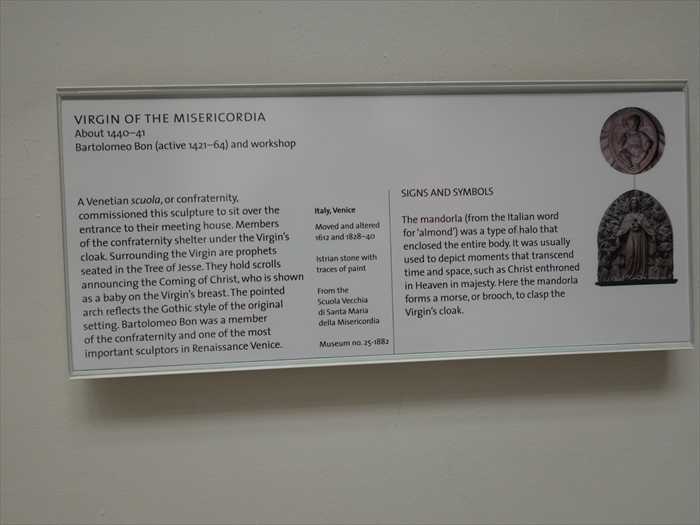
サン・フェリーチェ教会の内陣仕切り(Tramezzo / Choir Screen) 下から
「 建築的ファサード構造(コーラスクリーン/教会の内陣仕切り壁) 」を。

後期ゴシック~ルネサンス祭壇画ギャラリー 。
写真に写っている
多翼祭壇(altarpieces)は主に 15~16世紀のスペイン、フランドル、ドイツ圏 の 作品で、
どれも彩色木彫+金箔 が施されていた。
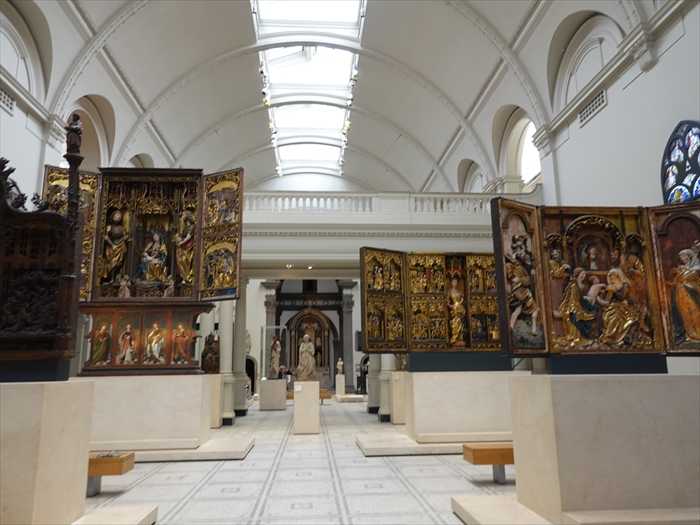
・左手前(黒い台座に載る祭壇画)

「 ALTARPIECE WITH THE VIRGIN AND CHILD AND SAINTS
in Latinas the agnus dei, or ‘lamb of God’. In ancient rites the lamb was often offered as a sacrifice. It later became a symbol for Jesus because Christians believed thathe sacrificed
himself on the cross.」
【 聖母子と聖人たちの祭壇画
ラテン語で「アニュス・デイ (Agnus Dei)」、すなわち「神の小羊」と呼ばれるものです。
古代の儀式では子羊はしばしば犠牲として捧げられましたが、後にキリスト教ではイエス自身が
十字架上で自らを犠牲にしたことを象徴するものとなりました。】
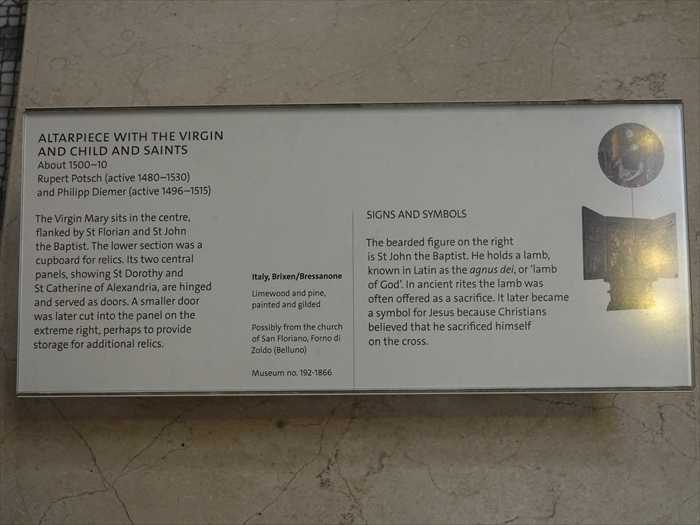
・中央奥(黄金の細密彫刻祭壇)
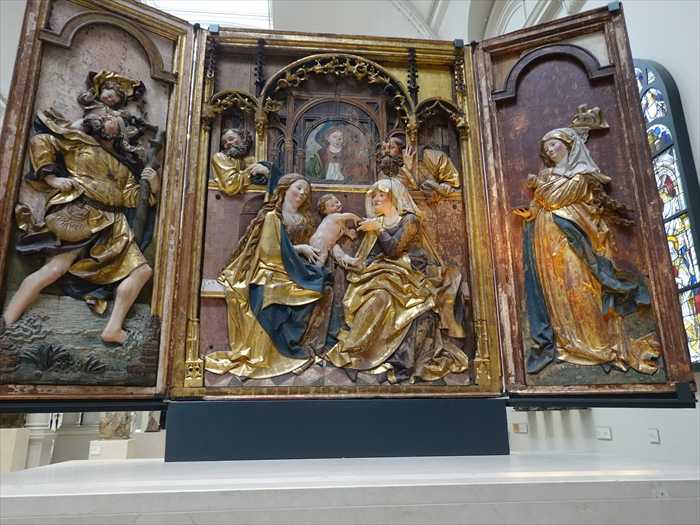
「 THE BOPPARD ALTARPIECE
【 ボッパルトの祭壇画
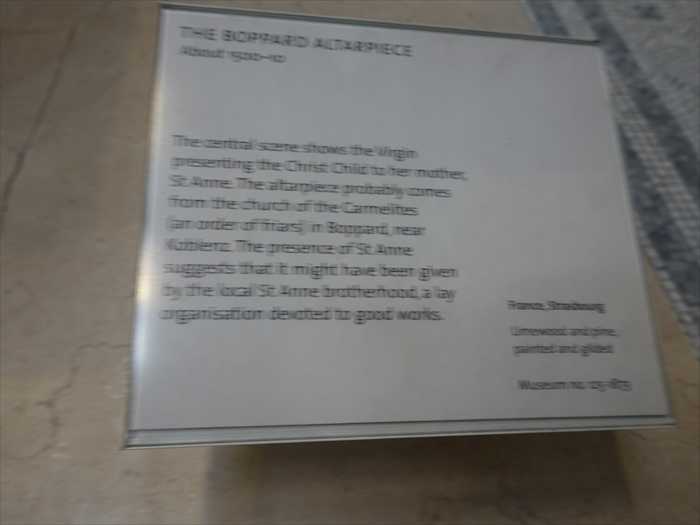
これは ゴシック~ルネサンス期のステンドグラス で、「 磔刑(Crucifixion) 」場面を描いていると。

このステンドグラスは、ゴシック様式の教会窓の一部で、上段と下段で異なる場面が
描かれている と。
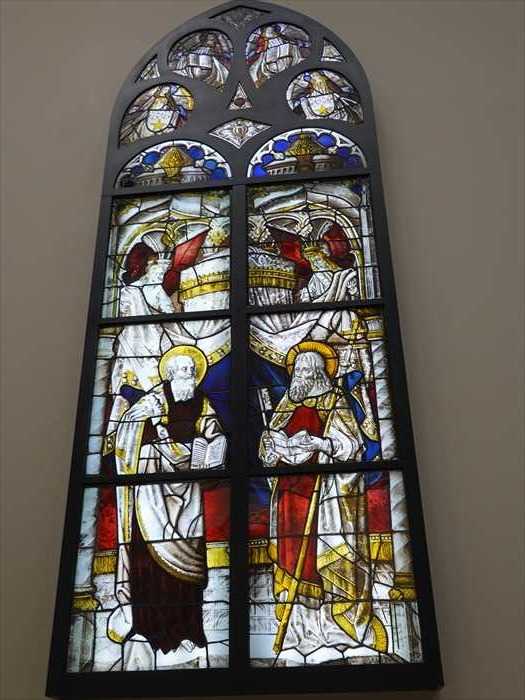
写真の窓(左から右へ)
この2枚の大窓は、V&A美術館の「ドイツ・スイスのステンドグラス」コレクションの中でも
特に物語性の強いパネルである と。
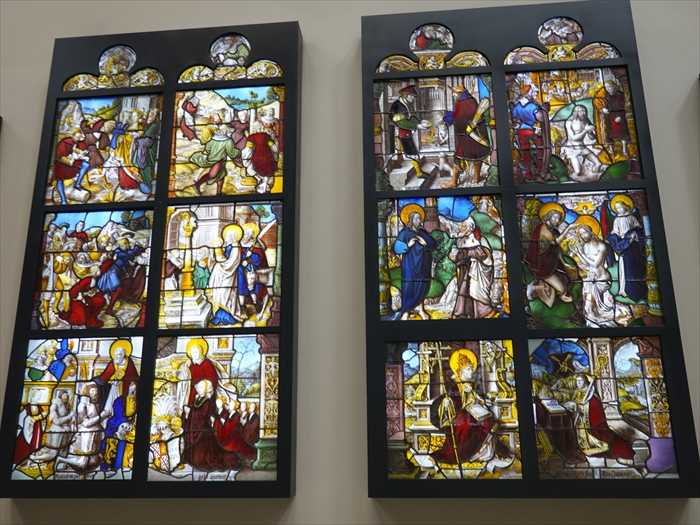
これは精巧な 木彫の祭壇衝立(リターブル / アルターピース) 。

「 ALTARPIECE WITH THE LIFE OF THE VIRGIN
【 聖母の生涯を描いた祭壇画 1520年頃
聖母マリアの生涯は、祭壇画において人気の主題でした。中央の場面は、聖母の死と被昇天を
表しています。その下にいるうずくまった人物像は「シナゴーグ(ユダヤ教会堂)」の擬人像で、
当時のキリスト教徒にとってはユダヤ教に対する勝利を象徴するものでした。このような
祭壇画はブリュッセルで一般的に制作され、注文生産されることもあれば、既製品として販売
されることもありました。
制作地:南ネーデルラント(ベルギー)、ブリュッセル
素材:オーク材
所蔵番号:1049-1859】
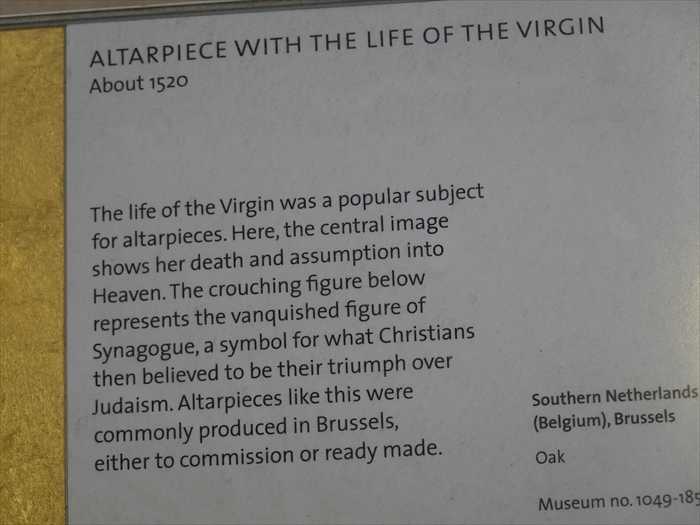
・この展示室は「 The Medieval Renaissance 1300–1600 」セクションに属し、イタリアの
宗教芸術を再構成したハイライト空間のひとつ。
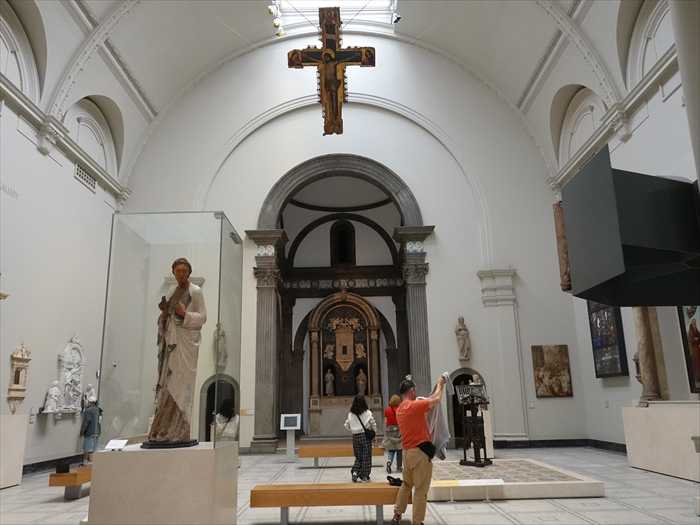
天井からは 金色に光る磔刑のキリスト が。
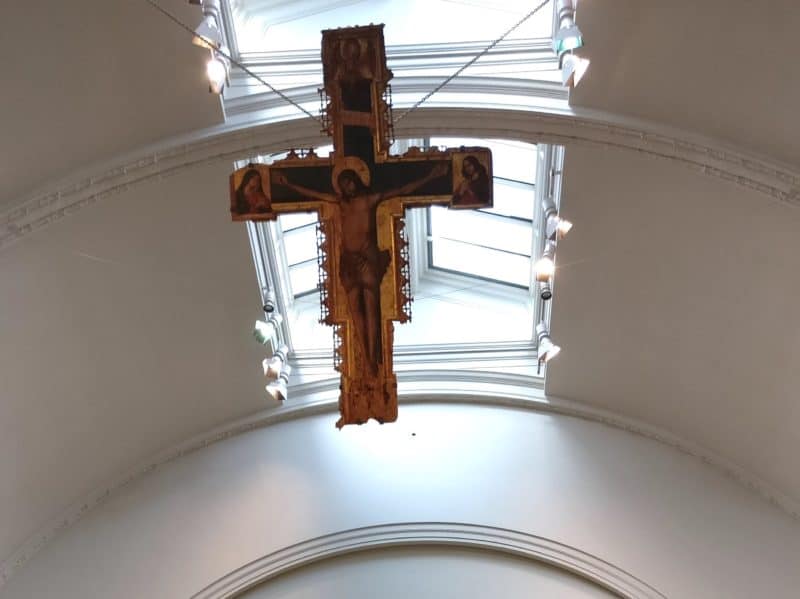
The Paul and Jill Ruddock Galleryを振り返って。

右手に展示されていた ステンドグラス 。

「The Paul and Jill Ruddock Gallery」(イタリア・ルネサンス彫刻ギャラリー) に
展示されている大理石の祭壇(アルターピース)。

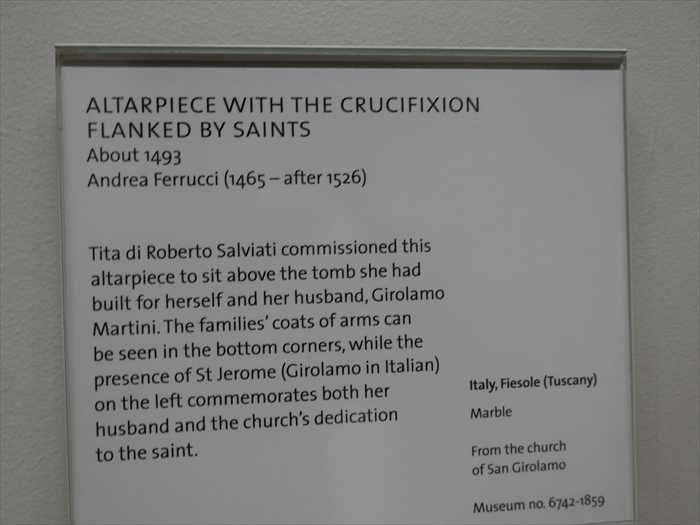
左側

ズームして。
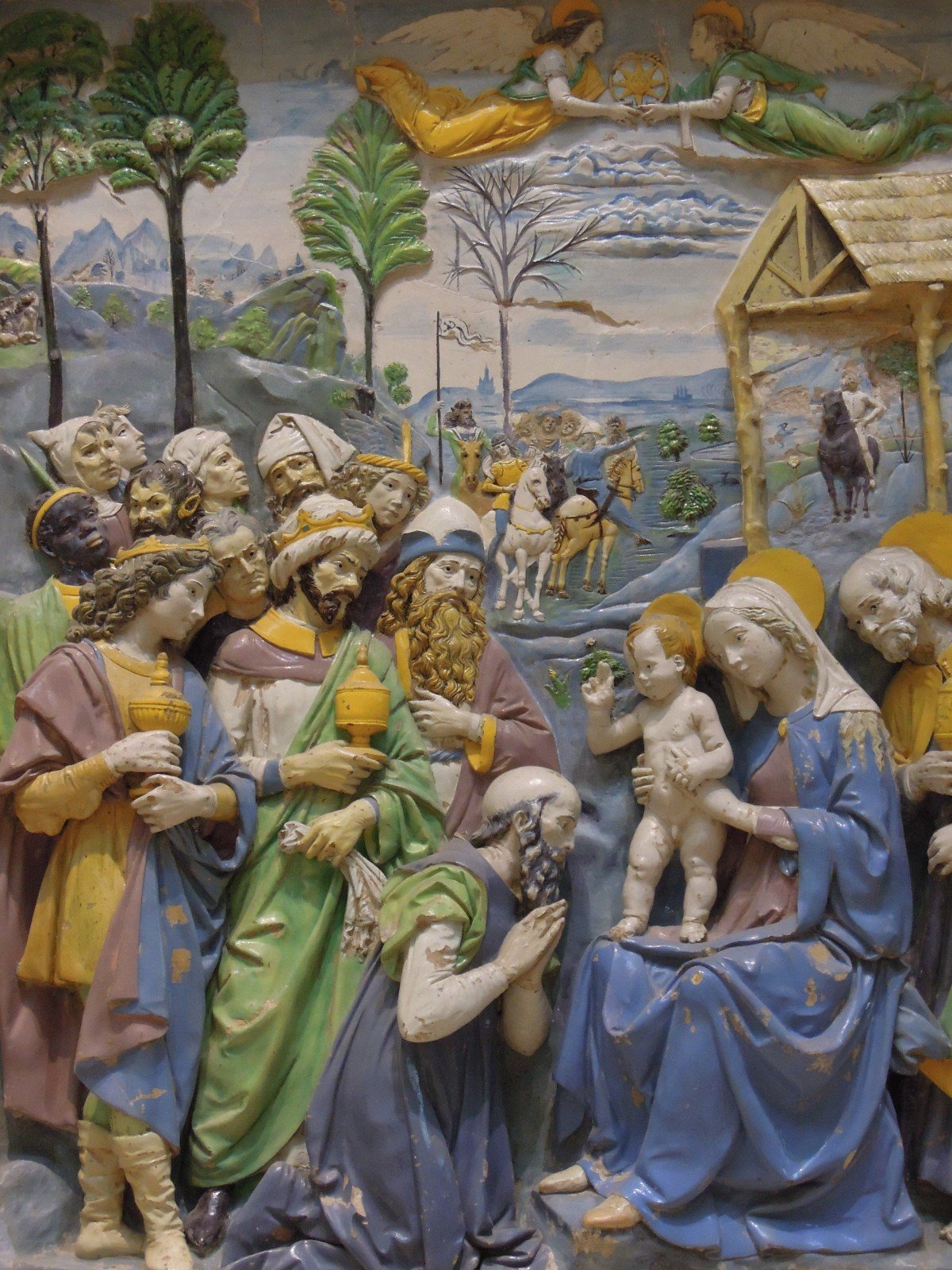
さらに

「 THE ADORATION OF THE KINGS
【東方三博士の礼拝1500年頃 – 1510年頃アンドレア・デッラ・ロッビア(1435–1525)
下部パネルに見られる紋章は、富裕なアルビッツィ家がこの祭壇装飾を依頼したことを
示している。博士たちの従者が身につけている異国風の頭飾り(アフリカ人を含む)は、
彼らが東方から来たことを象徴している。祭壇装飾の鮮やかな色彩は、スズ釉を施した
テラコッタ制作におけるデッラ・ロッビア工房の卓越した技を示している。
イタリア、フィレンツェ
スズ釉テラコッタ
館蔵番号:4412-1857】

両像とも V&A の「 The Paul and Jill Ruddock Gallery 」で展示されているもの

「 ST ANTHONY ABBOT AND ST STEPHEN
the poorer members of the congregation. Here, however, he is shown in the robes
of a medieval deacon, who would have assisted priests during the Mass. He is
alsorecognisable by the stones on his head and shoulder, reminding believers that
he was stoned to death.」
【 聖アントニウス修道院長と聖ステファノ
役割を担っていた。ここでは、中世の助祭の法衣をまとった姿で表されており、彼がミサの間に
司祭を補助する人物であったことを示している。また、彼の頭や肩に付けられた石は、彼が
石打ちによって殉教したことを信徒に想起させる。】
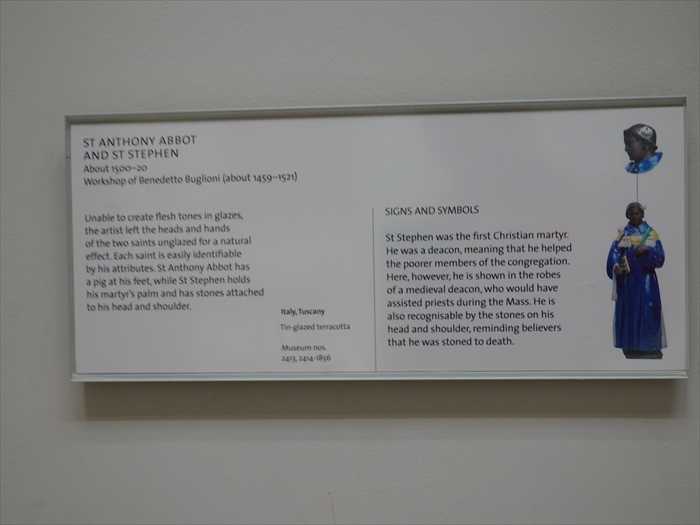
「The Paul and Jill Ruddock Gallery」に展示されている デッラ・ロッビア工房(Della Robbia workshop) の多彩色施釉テラコッタ祭壇装飾 。 これは 「聖母子と天使たち」 あるいは
「玉座の聖母(Madonna in Glory)」 を表す場面。
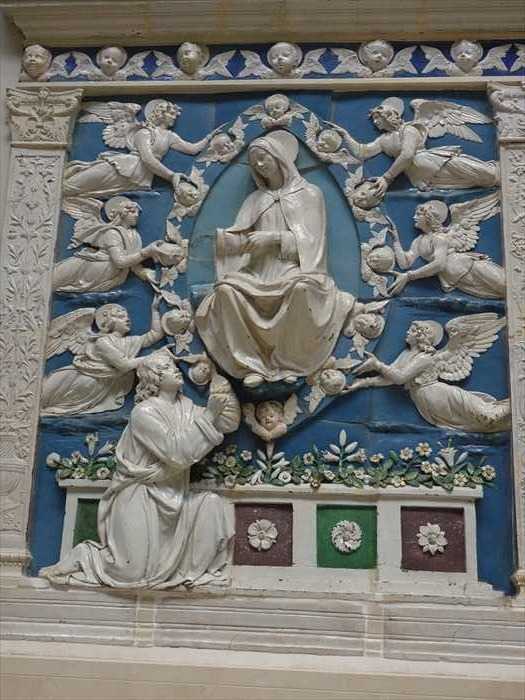
「Screen from Ávila Cathedral(1520–30, Spain, Ávila)」 この鉄製スクリーンは、
アビラ大聖堂(スペイン、カスティーリャ地方) の広大な柵の一部。

「 SCREEN FROM AVILA CATHEDRAL
【アビラ大聖堂のスクリーン(仕切り柵)1520年–1530年頃ロレンソ・デ・アビラ
(1525年頃活動)の工房による可能性が高いスクリーンは祭壇や私的礼拝堂を保護するために
用いられ、ヨーロッパ中の教会で一般的であった。このアビラ大聖堂の大きなスクリーンの
一部は、バラスター(欄干の支柱)から成り、地元の鉄細工師ロレンソ・デ・アビラとその
工房が好んで用いた様式である。以前のスペインのスクリーンでは、ねじれた鉄棒を用いる
のがより一般的であった。
スペイン、アビラ
鉄製
館蔵番号:不明(表示欠落)】

典礼用の聖職者衣装(Liturgical Vestments) 。

1.左端
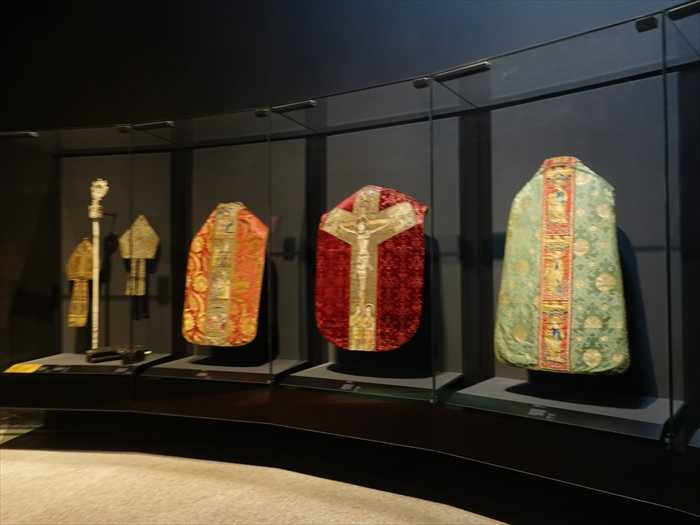
「Tapestry with St Antoninus」(1450–1500年頃)
・描かれているのは 聖アントニヌス(St Antoninus, 1389–1459)
・1446–1459年までフィレンツェ大司教を務めた人物。
・ドミニコ会士であったため、黒と白の修道服(habit of the Dominican order)を着用。
・司教冠(miter)をかぶり、司教杖(crosier)を持ち、右手は祝福の姿勢。
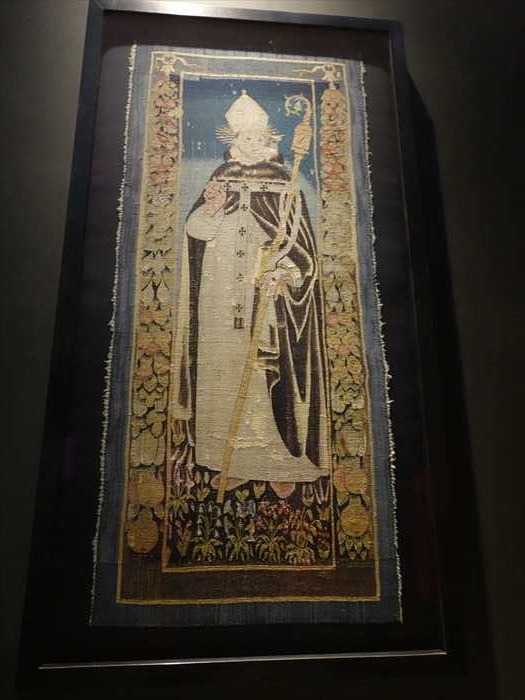
「 TAPESTRY WITH ST ANTONINUS
【 聖アントニヌスのタペストリー
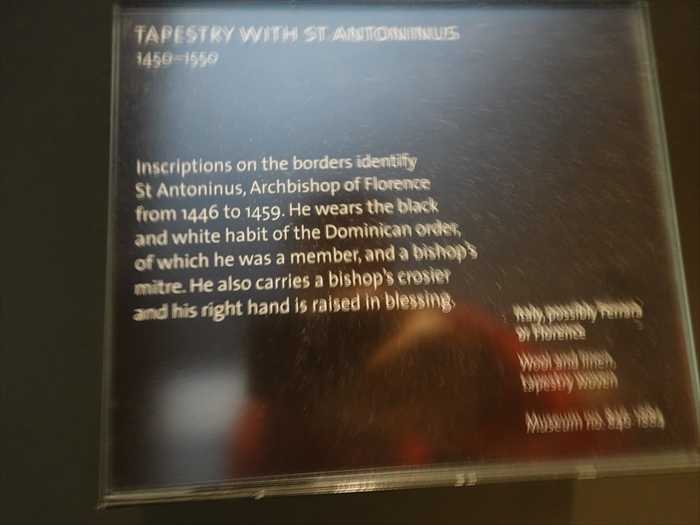
教会で用いられる 典礼用金属器(liturgical vessels and objects) の展示。
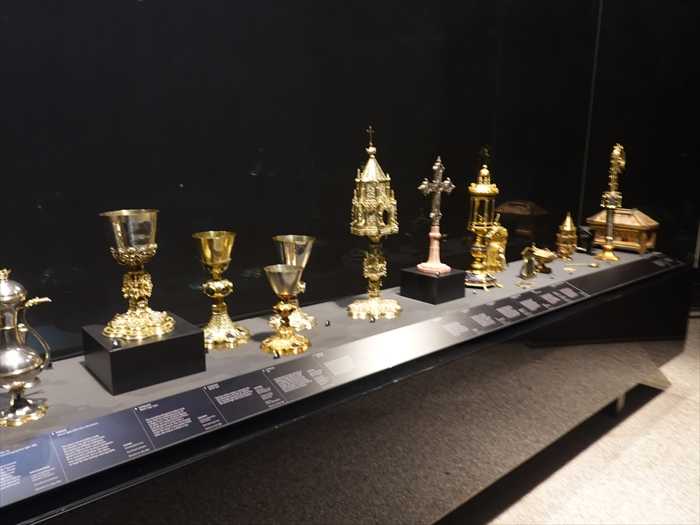
ズームして。典礼用金属器の中でも特に重要な 聖遺物容器(Reliquaries) と
祭壇十字架(Altar Cross) 。
右(八角形ベースの塔型)

・・・ もどる ・・・
・・・ つづく ・・・
ヴィクトリア&アルバート博物館(V&A, ロンドン) の
Medieval & Renaissance 1350–1600 ギャラリー 👈️リンクを進む。
1.中央手前の噴水
・八角形の基壇を持つ噴水(well head)。
イタリア・ルネサンス期の庭園や邸宅に設置されていたもので、展示室のシンボル的存在。
2.中央奥の二体の彫像
・それぞれルネサンス期の大理石像やブロンズ像(例:「サムソン」や「プロセルピナの略奪」
など)と同系列の展示。人間の動きや肉体美を強調。
3.奥に見える黒い大きな構造物
・これは Tomb of Gaston de Foix(ガストン・ド・フォワの墓:1512頃) の複製です。
元はイタリア・ミラノのサンティ・マルチェリーノ・エ・ピエトロ教会に計画された
壮大な墓廟。
実際には未完成でしたが、そのデザインが後世に伝わり、V&A では黒い石膏モデルとして
展示されていた。
4.右手壁面の大きな枠付き彫刻
・聖母子像やキリスト磔刑を伴う宗教的浮彫(ルネサンス期の教会装飾から移されたもの)。

・左側(男性像):
→ 「 Zephyr(ゼピュロス) 」とされるもの。ギリシア神話において「西風の神」で、
男性の神格。展示されている像も、筋肉質な男性の裸体像として表現されていて、足元に小さな
裸体で、左に布を垂らし、足元にイルカのような海のモチーフが彫られているのが特徴。
・右側(男性像):
→ 「 アポロ像(Apollo) 」と考えられる像。腕に子供(小さな人物=キューピッドや音楽的
属性を持つ存在)を抱えているように見えます。これらはどちらも ルネサンス期イタリアの
神話主題彫刻 で、理想化された人体美を示す代表的な作例として並べて展示されていた。

ZEPHYR
1576
Pietro Francavilla (1548–1615)
Together with the statue of Apollo nearby, this was one of a series of thirteen sculptures representing ancient Roman gods and nymphs associated with nature. Zephyr was
thegod of the west wind, redolent of springtime and flowers. He is identified by the
blowing cherub by his foot.
thegod of the west wind, redolent of springtime and flowers. He is identified by the
blowing cherub by his foot.
Italy, Florence
Marble
Lent by the Royal Botanic Gardens, Kew」【 ゼピュロス(西風の神)
1576年
ピエトロ・フランカヴィッラ(1548–1615)
近くにあるアポロ像と共に、これは自然に関連する古代ローマの神々やニンフを表した13体の
彫刻シリーズの一つです。ゼピュロスは西風の神で、春や花を想起させる存在でした。
足元に彫られた息を吹きかけるケルブ(天使像)によって識別されます。
イタリア、フィレンツェ
大理石
キュー王立植物園からの貸与】
騎馬像を中心とする大きな壁龕彫刻(レリーフ)。

ズームして。
上段は the Monument Of Marchese Spinetta Malaspina(マルケーゼ・スピネッタ・
マラスピーナ記念碑) であると。
・原作:14世紀前半、イタリア・サルザーナ大聖堂(Duomo di Sarzana)
・内容:天幕の下、馬上のマラスピーナ侯と従者。墓碑的モニュメント。
・V&A展示は石膏キャスト(19世紀制作)。

下段 をズームして。 聖母子と聖人像の小祭壇的群像(Tabernacle / Altarpiece fragments)
・中央:玉座の聖母子像(Madonna and Child)
・両脇:聖人像(恐らく聖ヨハネ、聖ペテロ、聖パウロ、聖カタリナなど典型的組み合わせ)
・構造:アーチ型ニッチに収められた5体、赤茶色のフレームに白色大理石像。
・出典:イタリア・フィレンツェ周辺のルネサンス期(15世紀前半〜中期)の作品と考えられ、
オリジナルは別の小祭壇・タベルナクルからの部分。
オリジナルは別の小祭壇・タベルナクルからの部分。
・ V&Aではマラスピーナ騎馬像キャストの下に「装飾的な補完」として配置
。
上段と下段は本来別作品。
上段と下段は本来別作品。
V&Aキャストコートでは、視覚的効果を高めるために上下を組み合わせ展示している と。

V&Aキャスト・コートの全景。V&Aキャスト・コートは世界の有名な彫刻作品のレプリカだけを
収めた部屋。
1.中央奥(黒い大構造物)
・ルネサンス期の教会内部を飾った内陣仕切り(オリジナルはイタリア)。
・二層構造で、下層は三連アーチ+円柱、上層はバルコニーと人物像。
・人物像は聖人や寓意像(信仰・希望・愛など)を表している。
2.中央手前の二体の裸体像
・右側:Zephyr(ゼピュロス)(西風の神)1576年、ピエトロ・フランカヴィッラ作。
・左側:Apollo(アポロン)(ギリシア神話の太陽神/芸術と音楽の守護神)。
・どちらもフィレンツェで制作され、自然や神話に関連する神々として庭園装飾に使われていた。
3.左手前の噴水
・ブロンズ製の小型噴水。キャストコートに合わせて設置されており、イタリア庭園や広場の
雰囲気を演出。
雰囲気を演出。
4.右手前の八角形の石造物
・「井戸の井桁(Well Head)」ヴェローナ産大理石製。
・イタリア・ルネサンス期の邸宅中庭に設置され、紋章や寓意的装飾が施されている。

サン・フェリーチェ教会の内陣仕切り(Tramezzo / Choir Screen)。

・オリジナル所在地:
イタリア・ボローニャの San Petronio Basilica(サン・ペトロニオ聖堂) 、
またはフィレンツェの San Lorenzo(サン・ロレンツォ聖堂) の内陣仕切りと同系統の作品。
・展示品:
黒地と赤大理石風の柱に、白色石膏で鋳造した人物像が並ぶ。
・19世紀に石膏キャストとして制作
され、オリジナルはイタリア・ルネサンス建築の代表的な
教会内装の一部。
・構造
教会内装の一部。
・構造
・下層:
三連アーチ。赤大理石風の円柱。アーチ上に人物像。
・上層:
バルコニー形式。胸像や立像が交互に配置。
・彫像:
聖人・旧約の預言者・寓意像などが含まれる。

手前の
石棺(tomb effigies/墓碑像) 。
鎧姿で剣を持ち、手を合わせて祈る姿で横たわる「騎士の墓碑像」。
サンティアゴ騎士団の騎士 ドン・ガルシア・デ・オソリオ(1505–1509没)の墓碑像
(アルバスター製)奥にもう一体あったのは「 妻の墓碑像 」
・材質:
オリジナルは大理石やアルバスター(雪花石膏)。展示されているのはその石膏キャスト。
・姿勢:
両手を合わせて祈り、騎士としての甲冑姿で横たわる。
これは典型的な「エフィジー(effigy)」様式。
これは典型的な「エフィジー(effigy)」様式。
・足元:
手前の像の足元には「ライオン」が彫られており、勇気と忠誠を象徴。
・時代:
14~15世紀のイングランドで多く見られる墓碑スタイル。

移動して。

さらに

「 EFFIGY OF DON GARCÍA DE OSORIO
Died 1509–1505
Don García, a knight of the Order of Santiago, was buried in the church of San Pedro
in Toledo. Though he wears chain mail and armour, his helmet has been removed and
placed at his feet, with a symbolic figure of mourning. His wife’s effigy nearby has
a similar figure at her feet.
in Toledo. Though he wears chain mail and armour, his helmet has been removed and
placed at his feet, with a symbolic figure of mourning. His wife’s effigy nearby has
a similar figure at her feet.
Spain, Toledo
Alabaster
Museum no. A.48-1910」 【 ガルシア・デ・オソリオの墓碑像
没年:1505–1509
ドン・ガルシアはサンティアゴ騎士団の騎士であり、トレドのサン・ペドロ教会に埋葬された。
彼は鎖かたびらと甲冑を身につけているが、兜は脱がれて足元に置かれ、その横には
「嘆きの象徴的人物像」が添えられている。近くに安置された妻の墓碑像にも同様に、
足元に小像が置かれている。制作地:スペイン、トレド
彼は鎖かたびらと甲冑を身につけているが、兜は脱がれて足元に置かれ、その横には
「嘆きの象徴的人物像」が添えられている。近くに安置された妻の墓碑像にも同様に、
足元に小像が置かれている。制作地:スペイン、トレド
材質:アラバスター(雪花石膏)
館蔵番号:A.48-1910】「 SIGNS AND SYMBOLS
The cross on the left breast of Don García de Osorio’s cloak shows that he belonged
to the Order of Santiago, a combined military and religious order dedicated toSt James
and founded in the 12th century. The lowest arm of the cross resembles a sword blade
and reflects the dual nature of the Order.」
【 ガルシア・デ・オソリオの墓碑像
ドン・ガルシアはサンティアゴ騎士団の騎士であり、トレドのサン・ペドロ教会に埋葬された。
彼は鎖かたびらと甲冑を身につけているが、兜は脱がれて足元に置かれ、その横には
「嘆きの象徴的人物像」が添えられている。近くに安置された妻の墓碑像にも同様に、
足元に小像が置かれている。】
彼は鎖かたびらと甲冑を身につけているが、兜は脱がれて足元に置かれ、その横には
「嘆きの象徴的人物像」が添えられている。近くに安置された妻の墓碑像にも同様に、
足元に小像が置かれている。】

反対側・左側の墓碑像 。
・左側(手前)の棺 → 女性像(長衣をまとい、胸の上で両手を組む姿)。
・右側(奥)の棺 → 男性像(甲冑姿で剣を抱えた典型的な騎士像)。
・素材はいずれもアルバスター。制作はスペイン・トレド周辺(15世紀末~16世紀初頭)が多い。
・背後の壁龕(ニッチ)には「聖母と子、周囲に天使」の大型浮彫があり、墓碑群全体を宗教的に
囲む配置。
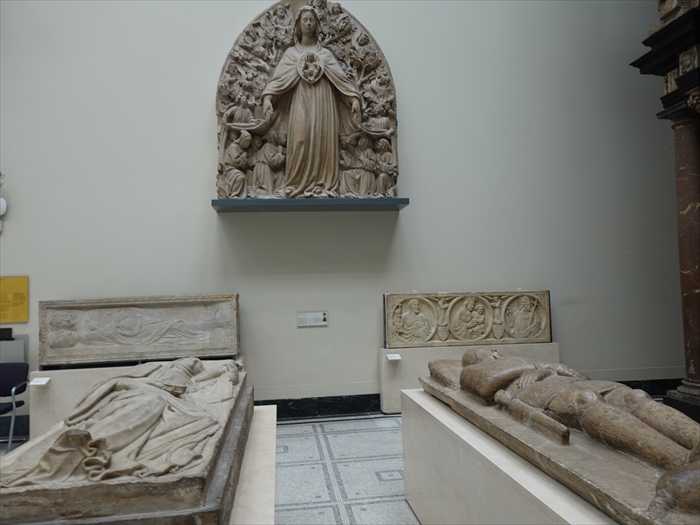
囲む配置。

「 Virgin of the Misericordia(慈悲の聖母) 」。

「 VIRGIN OF THE MISERICORDIA
About 1440–49
Bartolomeo Bon (active 1421–64) and workshop
A Venetian scuola, or confraternity, commissioned this sculpture to sit over the entrance
to their meeting house. Members of the confraternity shelter under the Virgin's cloak. Surrounding the Virgin are prophets seated in the Tree of Jesse. They hold scrolls
announcing the Coming of Christ, who is shown as a baby on the Virgin's breast.
The pointed arch reflects the Gothic style of the original setting. Bartolomeo Bon was a
member of the confraternity and one of the most importantsculptors
in Renaissance Venice.
to their meeting house. Members of the confraternity shelter under the Virgin's cloak. Surrounding the Virgin are prophets seated in the Tree of Jesse. They hold scrolls
announcing the Coming of Christ, who is shown as a baby on the Virgin's breast.
The pointed arch reflects the Gothic style of the original setting. Bartolomeo Bon was a
member of the confraternity and one of the most importantsculptors
in Renaissance Venice.
Italy, Venice
Moved and altered 1618 and 1828–30
Istrian stone with traces of paint
From the Scuola Vecchia di Santa Maria della Misericordia
Museum no. 25-1883
SIGNS AND SYMBOLS
the entire body. It was usually used to depict moments that transcended time and
space, such as Christ enthroned in Heaven in majesty. Here the mandorla forms a
morse, or brooch, to clasp the Virgin's cloak.」
【 憐みの聖母(ヴィルジン・オブ・ザ・ミゼリコルディア)
1440~1449年頃
バルトロメオ・ボン(1421–64年活動)および工房
ヴェネツィアのスコーラ(信徒会、同信会)は、この彫刻を集会所の入口上部に設置するために
制作を依頼しました。 同信会の会員たちは聖母のマントの下に庇護される姿で表されています。
聖母を囲むのは「エッサイの樹」に座る預言者たちで、彼らは巻物を掲げ、キリストの降誕を
告げています。キリストは聖母の胸に抱かれる幼子として表現されています。 尖塔型アーチは
当初の設置場所のゴシック様式を反映しています。 バルトロメオ・ボン自身もこの同信会の
会員で、ルネサンス期ヴェネツィアを代表する重要な彫刻家の一人でした。
制作を依頼しました。 同信会の会員たちは聖母のマントの下に庇護される姿で表されています。
聖母を囲むのは「エッサイの樹」に座る預言者たちで、彼らは巻物を掲げ、キリストの降誕を
告げています。キリストは聖母の胸に抱かれる幼子として表現されています。 尖塔型アーチは
当初の設置場所のゴシック様式を反映しています。 バルトロメオ・ボン自身もこの同信会の
会員で、ルネサンス期ヴェネツィアを代表する重要な彫刻家の一人でした。
制作地:イタリア、ヴェネツィア
1618年および1828–30年に移設・改変
イストリア石(一部彩色痕跡あり)
出典:サンタ・マリア・デッラ・ミゼリコルディア信徒会館(Scuola Vecchia)
館蔵番号:25-1883
記号と象徴
通常、時間や空間を超越した出来事、例えば天に威厳をもって座すキリストなどを表現する際に
用いられます。ここではマンドルラは、聖母のマントを留める留め具(ブローチ)の形を
とっています。】

サン・フェリーチェ教会の内陣仕切り(Tramezzo / Choir Screen) 下から
「 建築的ファサード構造(コーラスクリーン/教会の内陣仕切り壁) 」を。
・手前:
黒と赤大理石風の円柱とアーチ(V&A に再構成された Choir Screen の一部)。
・奥:
祭壇画(Altarpieces)が並ぶ展示スペース。多翼祭壇(polyptych)や黄金背景の板絵が
立てられている。
立てられている。
・最遠方:
さらにもう一つのアーチ越しに別の祭壇装飾(白大理石風の枠に収まった作品)
が見える。
が見える。

後期ゴシック~ルネサンス祭壇画ギャラリー 。
写真に写っている
多翼祭壇(altarpieces)は主に 15~16世紀のスペイン、フランドル、ドイツ圏 の 作品で、
どれも彩色木彫+金箔 が施されていた。

・左手前(黒い台座に載る祭壇画)
・フランドル地方の多翼祭壇(15世紀末頃)
・中央に「受胎告知」「キリスト誕生」「東方三博士の礼拝」など新約聖書の場面が
金箔木彫で表されている。
金箔木彫で表されている。
・下段(プレデッラ)には聖人群の絵画が残る。

「 ALTARPIECE WITH THE VIRGIN AND CHILD AND SAINTS
About 1500–10
Rupert Potsch (active 1480–1530) and Philipp Diemer (active 1496–1515)
The Virgin Mary sits in the centre, flanked by St Florian and St John the Baptist.
The lower section was a cupboard for relics. Its two central panels, showing
St Dorothyand St Catherine of Alexandria, are hinged and served as doors.
A smaller door waslatercut into the panel on the extreme right, perhaps to
provide storage for additional relics.
The lower section was a cupboard for relics. Its two central panels, showing
St Dorothyand St Catherine of Alexandria, are hinged and served as doors.
A smaller door waslatercut into the panel on the extreme right, perhaps to
provide storage for additional relics.
Italy, Brixen/Bressanone
Limewood and pine, painted and gilded
Possibly from the church of San Floriano, Forno di Zoldo (Belluno)
Museum no. 192-1866
SIGNS AND SYMBOLS
The bearded figure on the right is St John the Baptist. He holds a lamb, knownin Latinas the agnus dei, or ‘lamb of God’. In ancient rites the lamb was often offered as a sacrifice. It later became a symbol for Jesus because Christians believed thathe sacrificed
himself on the cross.」
【 聖母子と聖人たちの祭壇画
1500~1510年頃
ルーペルト・ポッチュ(1480–1530頃 活躍)、フィリップ・ディーマー(1496–1515頃 活躍)
聖母マリアは中央に座り、その左右には聖フロリアンと洗礼者聖ヨハネが並んでいます。
下段部分は聖遺物を収める収納庫として作られました。中央の二枚のパネルには聖ドロテアと
アレクサンドリアの聖カタリナが描かれており、蝶番で取り付けられて扉の役割を果たしました。
右端のパネルには後から小さな扉が切り込まれ、追加の聖遺物を納める収納として使われた
可能性があります。
下段部分は聖遺物を収める収納庫として作られました。中央の二枚のパネルには聖ドロテアと
アレクサンドリアの聖カタリナが描かれており、蝶番で取り付けられて扉の役割を果たしました。
右端のパネルには後から小さな扉が切り込まれ、追加の聖遺物を納める収納として使われた
可能性があります。
制作地:イタリア、ブリクセン/ブレッサノーネ
材質:シナノキ材と松材、彩色・金箔
出典:ベッルーノ県、サン・フロリアーノ教会(Forno di Zoldo)から伝来の可能性あり
所蔵番号:192-1866
記号と象徴
右側のひげをたくわえた人物は洗礼者聖ヨハネです。彼は子羊を抱いています。ラテン語で「アニュス・デイ (Agnus Dei)」、すなわち「神の小羊」と呼ばれるものです。
古代の儀式では子羊はしばしば犠牲として捧げられましたが、後にキリスト教ではイエス自身が
十字架上で自らを犠牲にしたことを象徴するものとなりました。】

・中央奥(黄金の細密彫刻祭壇)
・ドイツ・ザクセン地方、あるいはスペイン北部の工房作(15~16世紀初頭)
・小区画に分かれ、旧約・新約の場面をびっしりと物語風に展開。
・金地背景により劇的な効果を持たせている。
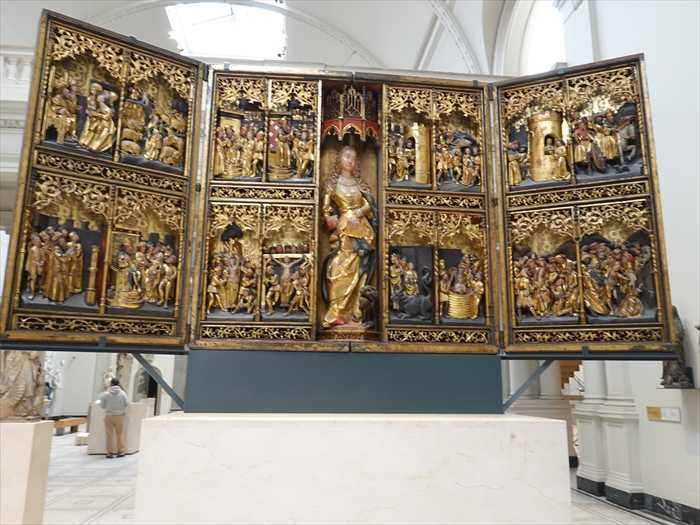
近づいて。
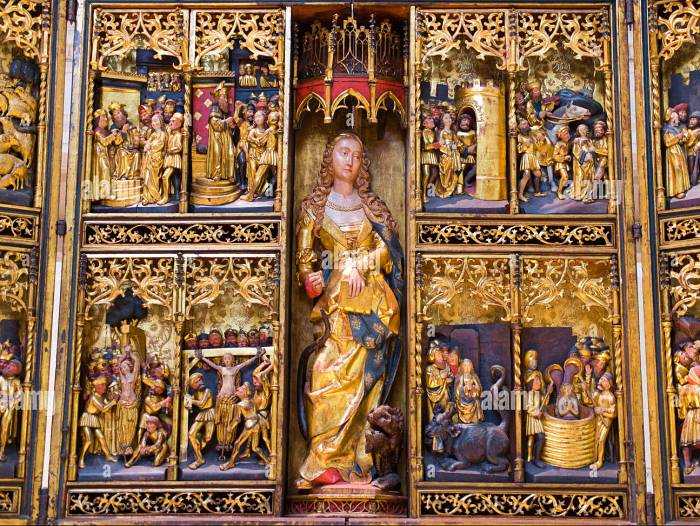
「 THE ST MARGARET ALTARPIECE

近づいて。
・中央像:
冠を戴かず立つ女性聖人像(獅子を伴っている)。これは 聖カタリナ
(St. Catherine of Alexandria) または 聖マルガリタ(St. Margaret of Antioch) と
考えられます。特に足元の竜や蛇を踏む姿は聖マルガリタの典型的図像です。
(St. Catherine of Alexandria) または 聖マルガリタ(St. Margaret of Antioch) と
考えられます。特に足元の竜や蛇を踏む姿は聖マルガリタの典型的図像です。
・周囲のパネル:
金箔背景の浮彫で、新約の受難や殉教の場面がぎっしり。
左下には磔刑、 右側には鞭打ちや裁判の場面があり、物語的に展開しています。
左下には磔刑、 右側には鞭打ちや裁判の場面があり、物語的に展開しています。
・様式:
細密なゴシック様式の透かし彫り(フランドルやドイツの15世紀後半によく見られる
様式)。
・彩色: ポリクローム彩色が残り、金地に赤や青の衣服の彩色が強く出ています。
様式)。
・彩色: ポリクローム彩色が残り、金地に赤や青の衣服の彩色が強く出ています。

「 THE ST MARGARET ALTARPIECE
About 1490–1500
This imposing altarpiece tells the story of St Margaret, who was martyred for refusing to renounce Christianity. It was common practice for many craftsmen to work together on
such large altarpieces. The style of the elongated heads in the two lower rightpanels,
so different from the others, suggests that they were made by a different artist.
such large altarpieces. The style of the elongated heads in the two lower rightpanels,
so different from the others, suggests that they were made by a different artist.
Germany, Hamburg or Lüneburg
Oak, painted and gilded
Possibly from the church of St John, Lüneburg
Museum no. 5894-1859」
【 聖マルガリタの祭壇画
【 聖マルガリタの祭壇画
1490~1500年頃
この堂々たる祭壇画は、キリスト教を棄てることを拒んだために殉教した聖マルガリタの物語を
伝えています。このような大規模な祭壇画では、多くの職人が共同で制作にあたるのが
一般的でした。右下の2枚のパネルに見られる長い頭部の表現は、他の部分と大きく異なって
おり、別の作者によって制作された可能性を示しています。
伝えています。このような大規模な祭壇画では、多くの職人が共同で制作にあたるのが
一般的でした。右下の2枚のパネルに見られる長い頭部の表現は、他の部分と大きく異なって
おり、別の作者によって制作された可能性を示しています。
制作地:ドイツ、ハンブルク または リューネブルク
材質:オーク材、彩色・金箔
出典:リューネブルクの聖ヨハネ教会から伝来した可能性あり
所蔵番号:5894-1859】
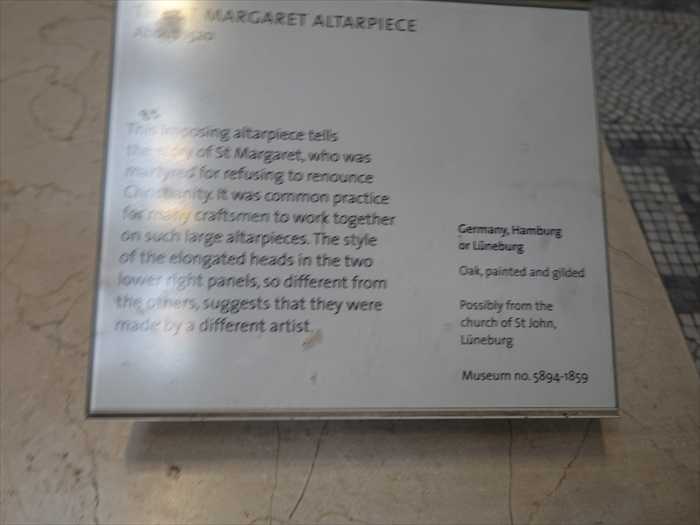
右手前 。15世紀末から16世紀初頭の ドイツやオーストリア圏の後期ゴシック祭壇画。

右手前 。15世紀末から16世紀初頭の ドイツやオーストリア圏の後期ゴシック祭壇画。
・中央パネル
・金地背景に、玉座に座る聖母マリアが幼子イエスを抱いています。
・左隣には女性聖人(多くの場合は 聖アンナ または 聖エリザベト)が描かれ、三世代の
聖なる女性 ― 聖アンナ・聖母マリア・幼子イエス ― からなる「聖アンナ三世代
(Anna Selbdritt)」の図像に近いです。
聖なる女性 ― 聖アンナ・聖母マリア・幼子イエス ― からなる「聖アンナ三世代
(Anna Selbdritt)」の図像に近いです。
・上部には聖人たちの小胸像(預言者や聖者)が装飾的に配置されています。
・左翼パネル
・聖クリストフォロス(クリストファー)が幼子イエスを肩に担ぎ、川を渡っている場面。
彼は旅人の守護聖人。
彼は旅人の守護聖人。
・右翼パネル
・頭に王冠を戴いた女性聖人像。衣装から判断すると 聖バルバラ(塔を持つ聖人) または
聖カタリナ(車輪の聖人)。残念ながら持ち物(アトリビュート)が欠けているため断定は
難しいですが、よくセットで登場する「聖なる乙女殉教者」のひとりである と。
聖カタリナ(車輪の聖人)。残念ながら持ち物(アトリビュート)が欠けているため断定は
難しいですが、よくセットで登場する「聖なる乙女殉教者」のひとりである と。

「 THE BOPPARD ALTARPIECE
About 1520–40
The central scene shows the Virgin presenting the Christ Child to her mother, St Anne. The altarpiece probably comes from the church of the Carmelites (an order of friars)in Boppard, near Koblenz. The presence of St Anne suggests that it might have been given by the local St Anne brotherhood, a lay organisation devoted to good works.
France, Strasbourg
Limewood and pine, painted and gilt
Museum no. 152-1919」 【 ボッパルトの祭壇画
1520~1540年頃
中央の場面には、聖母マリアが幼子イエスをその母聖アンナに差し出す姿が描かれています。
この祭壇画は、おそらくコブレンツ近郊ボッパルトにあるカルメル会(托鉢修道会)の教会に
由来するものです。聖アンナの姿があることから、この作品は地元の聖アンナ同信会
(善行に献身する信徒組織)によって奉納された可能性が示唆されます。
この祭壇画は、おそらくコブレンツ近郊ボッパルトにあるカルメル会(托鉢修道会)の教会に
由来するものです。聖アンナの姿があることから、この作品は地元の聖アンナ同信会
(善行に献身する信徒組織)によって奉納された可能性が示唆されます。
制作地:フランス、ストラスブール
材質:菩提樹材・松材、彩色および金箔
所蔵番号:152-1919】
これは ゴシック~ルネサンス期のステンドグラス で、「 磔刑(Crucifixion) 」場面を描いていると。
・中央上:
磔にされたイエス・キリスト
・十字架の左右上部:
兵士や群衆(受難の証人たち)
・イエスの左側(画面右):
聖ヨハネ(赤い衣、胸に手を当てる)
・イエスの右側(画面左):
聖母マリア(白いヴェールをまとい悲嘆に暮れる)
・ 十字架の足元中央:
マグダラのマリア(跪き、十字架に抱きついている)
この場面は新約聖書のヨハネによる福音書(19章25–27節)に基づきます。イエスが十字架上で
母マリアと弟子ヨハネに「これはあなたの子」「これはあなたの母」と語り、弟子たちに母を託す
場面を象徴的に表しているのだ と。
この場面は新約聖書のヨハネによる福音書(19章25–27節)に基づきます。イエスが十字架上で
母マリアと弟子ヨハネに「これはあなたの子」「これはあなたの母」と語り、弟子たちに母を託す
場面を象徴的に表しているのだ と。

このステンドグラスは、ゴシック様式の教会窓の一部で、上段と下段で異なる場面が
描かれている と。
上段(アーケード内の場面)
・王座(玉座)に座る人物を中心に、両脇に礼拝する聖職者や天使が描かれているように
見えます。
見えます。
・王冠をかぶり、権威を持つ人物なので、キリスト王 あるいは 旧約の王座を象徴する場面 と
解釈できる。
解釈できる。
上部のトレーサリー部分
・小型の円形パネルに、複数の聖人や聖職者が描かれています。これらは補助的に、
天上の礼拝を強調する装飾。
天上の礼拝を強調する装飾。
下段(主要パネル)
・左側の人物:
白い髭を持ち、本を広げる聖人。書物を持つことから 福音記者(おそらく 聖ヨハネまたは聖マタイ) を表している可能性が高い。
・右側の人物:
冠をかぶり、長い髭を持ち、王または預言者の姿。赤いマントをまとって いるので、旧約の王(ダビデ王、あるいはソロモン王) の可能性がある。

写真の窓(左から右へ)
1.最も左の細長い窓
・おそらく「旧約預言者」や「聖職者」の場面を上下に分けて描いた小型パネル。
・他の大窓の脇を飾る補助パネルで、構図的にはサイドランセット。
2.左から2番目の大窓(3列×3段)
・中央にマリアが描かれており、その周囲に受胎告知、訪問、誕生など新約の場面。
・「聖母マリアの生涯」シリーズ の窓の一部。
3.左から3番目の大窓(3列×3段)
・キリストの受難を中心にした場面(鞭打ち、十字架を担う、磔刑、復活など)が描かれて
いるように見えます。
いるように見えます。
・「キリストの受難」シリーズ の窓。
4.最も右の細長い窓
・天使の合唱や聖母戴冠を思わせる天上の場面が描かれている。
・これも補助的なランセット窓。


この2枚の大窓は、V&A美術館の「ドイツ・スイスのステンドグラス」コレクションの中でも
特に物語性の強いパネルである と。
左の窓(3段構成)・マリア伝
これは 「聖母マリアの生涯」 を描いた連作と考えられます。
・上段:
マリアの誕生、幼少期の奉献
・中段:
受胎告知、エリサベト訪問
・下段:
聖母の戴冠あるいはマリアへの崇拝場面(多くの聖人が跪く)
右の窓(3段構成)・キリスト伝(受難伝)
こちらは 「キリストの生涯(幼少期~受難)」 を物語順に示した可能性が高いです。
・上段:
東方三博士の礼拝、割礼(神殿での奉献)
・中段:
受難物語の序幕(オリーブ山の祈り、捕縛の場面)
・下段:
鞭打ち、荊冠、ピラトの前に立つキリスト

これは精巧な 木彫の祭壇衝立(リターブル / アルターピース) 。
・素材:
濃い色合いのオーク材(黒っぽい艶のある木材)で彫刻。
・構成:
中央の高い尖塔を中心に、三つの主場面(左・中央・右)+上部と台座部分に細かい
場面が配置。
場面が配置。
・技法:
極めて緻密なゴシック後期の浮彫(ハイ・リリーフ)で、衣の襞や人物の群像表現が
非常にリアル。
非常にリアル。
・図像:
中央に「聖母マリアの戴冠」または「聖母被昇天」が見られ、周囲に十二使徒や群衆
が配されています。
が配されています。
・左パネル:受胎告知やキリスト誕生に関連する場面。
・右パネル:たぶん受難(最後の晩餐や磔刑への前段階)。

「 ALTARPIECE WITH THE LIFE OF THE VIRGIN
About 1520
The life of the Virgin was a popular subject for altarpieces. Here, the central image shows
her death and assumption into Heaven. The crouching figure below represents the
vanquished figure of Synagogue, a symbol for what Christians then believed to betheir
triumph over Judaism. Altarpieces like this were commonly produced in Brussels,
either to commission or ready made.
her death and assumption into Heaven. The crouching figure below represents the
vanquished figure of Synagogue, a symbol for what Christians then believed to betheir
triumph over Judaism. Altarpieces like this were commonly produced in Brussels,
either to commission or ready made.
Southern Netherlands (Belgium), Brussels
Oak
Museum no. 1049-1859」 【 聖母の生涯を描いた祭壇画 1520年頃
聖母マリアの生涯は、祭壇画において人気の主題でした。中央の場面は、聖母の死と被昇天を
表しています。その下にいるうずくまった人物像は「シナゴーグ(ユダヤ教会堂)」の擬人像で、
当時のキリスト教徒にとってはユダヤ教に対する勝利を象徴するものでした。このような
祭壇画はブリュッセルで一般的に制作され、注文生産されることもあれば、既製品として販売
されることもありました。
制作地:南ネーデルラント(ベルギー)、ブリュッセル
素材:オーク材
所蔵番号:1049-1859】

・この展示室は「 The Medieval Renaissance 1300–1600 」セクションに属し、イタリアの
宗教芸術を再構成したハイライト空間のひとつ。
・見上げる 十字架像は「クローチフィッソ(Crocifisso)」と呼ばれる
イタリア中世の磔刑像群 の一例。
イタリア中世の磔刑像群 の一例。

天井からは 金色に光る磔刑のキリスト が。

The Paul and Jill Ruddock Galleryを振り返って。

右手に展示されていた ステンドグラス 。
中央場面(中段)
・左:聖母マリア(青い衣)に抱かれる幼子イエス。
・右:王冠をかぶった東方三博士の一人が、黄金の器を差し出している。
・主題は典型的な「東方三博士の礼拝(Adoration of the Magi)」。
上段
・後方で聖ヨセフと思われる男性(頭光を持つ)ともう一人の博士。
下段
・色鮮やかな紋章(黄地に黒点のような模様、両脇に白い翼状の装飾)。
・その下に部分的なラテン語銘文(「…TE VEN…」など読める)。
・寄進者家系の紋章と思われます。

「The Paul and Jill Ruddock Gallery」(イタリア・ルネサンス彫刻ギャラリー) に
展示されている大理石の祭壇(アルターピース)。

「 ALTARPIECE WITH THE CRUCIFIXION FLANKED BY SAINTS
About 1493
Andrea Ferrucci (1465 – after 1526)
Tita di Roberto Salviati commissioned this altarpiece to sit above the tomb she had
built for herself and her husband, Girolamo Martini. The families’ coats of arms can be
seen in the bottom corners, while the presence of St Jerome (Girolamo in Italian)
on the left commemorates both her husband and the church’s dedication to the saint.
built for herself and her husband, Girolamo Martini. The families’ coats of arms can be
seen in the bottom corners, while the presence of St Jerome (Girolamo in Italian)
on the left commemorates both her husband and the church’s dedication to the saint.
Italy, Fiesole (Tuscany)
Marble
From the church of San Girolamo
Museum no. 6742-1859」
【 聖人たちに囲まれた磔刑の祭壇画(アルターピース)
【 聖人たちに囲まれた磔刑の祭壇画(アルターピース)
制作年代:約1493年
作者:アンドレア・フェルッチ(1465年 – 1526年以降)
ロベルト・サルヴィアーティの娘ティタは、この祭壇画を、自身と夫ジローラモ・マルティーニの
ために造らせた墓の上に設置するために依頼した。家族の紋章は下部の隅に刻まれており、
左側に配された聖ヒエロニムス(イタリア語で「ジローラモ」)は、彼女の夫の名を記念する
とともに、この教会の守護聖人への献堂を示している。
ために造らせた墓の上に設置するために依頼した。家族の紋章は下部の隅に刻まれており、
左側に配された聖ヒエロニムス(イタリア語で「ジローラモ」)は、彼女の夫の名を記念する
とともに、この教会の守護聖人への献堂を示している。
イタリア、フィエーゾレ(トスカーナ)
大理石
出典:サン・ジロラモ教会
館蔵番号:6742-1859】

左側
・大きなアーチ型の枠に収められた祭壇画(または祭壇装飾)。
・絵画には聖母子(中央)、その両脇に二人の聖人(左は聖ペテロ?鍵を持つ、
右は聖フランチェスコ?修道服と縄帯)と思われる。
右は聖フランチェスコ?修道服と縄帯)と思われる。
・上部には二人の天使がホバリングし、巻物を広げている。
・枠はルネサンス期の典型的な大理石アーキトレーヴ(半円アーチ+コリント式柱)。
中央
・壁面に小型の彩色彫像が2体。
・左:修道服姿の男性聖人(茶色)。
・右:青い衣をまとった聖人像。
・おそらくイタリアのポリクローム木彫。
右側
・大型の彩釉テラコッタ浮彫(デッラ・ロッビア工房の様式)。
・主題は「東方三博士の礼拝(Adoration of the Magi)」:聖母子のもとに三博士が贈り物を
捧げる場面。
捧げる場面。
・周囲を青・緑・黄色の華やかな釉薬の装飾帯が囲む。
・ロッビア家(ルカ・デッラ・ロッビアやアンドレア・デッラ・ロッビア一派)がよく制作した
作品形式。
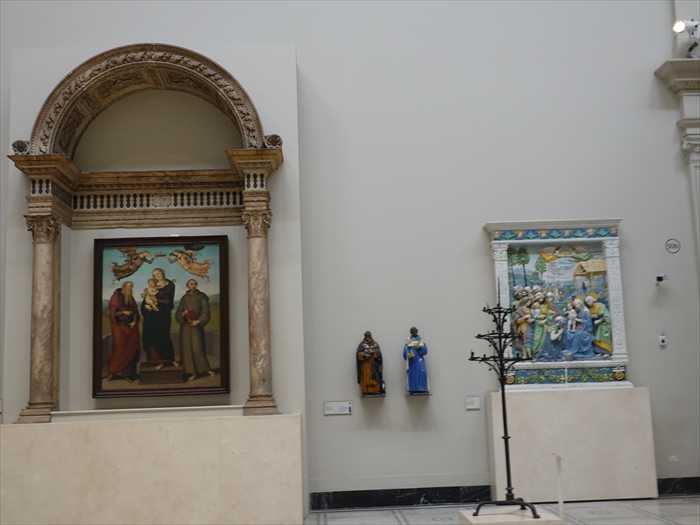
この作品は、 ルネサンス期フィレンツェを代表する陶芸一族 デッラ・ロッビア工房(Della Robbia workshop) による多彩色の施釉テラコッタ浮彫 。
作品形式。

この作品は、 ルネサンス期フィレンツェを代表する陶芸一族 デッラ・ロッビア工房(Della Robbia workshop) による多彩色の施釉テラコッタ浮彫 。
「 東方三博士の礼拝(Adoration of the Magi)
」
・中央:聖母マリアが幼子イエスを抱き、イエスは前に跪く博士に手を差し伸べています。
・右:ヨセフ(緑の外套)も寄り添い、博士たちの贈り物を見守る。
・左:三博士とその従者が列をなして、黄金・乳香・没薬を捧げる。先頭の博士は跪き、
深い敬意を表している。
深い敬意を表している。
・背景:馬に乗った従者、遠景の都市、放牧の羊などが描かれ、物語の広がりを示す。
・天上:二人の天使が飛翔しながら巻物を掲げ、聖性を強調。

ズームして。

さらに

「 THE ADORATION OF THE KINGS
About 1500–10
Andrea della Robbia (1435–1525)
The arms on the lower panel show that the wealthy Albizzi family commissionedthis
altarpiece. The exotic headgear worn by the kings’ followers(including an African man)
signifies that they were from the East. The bright colours of the altarpiece demonstrate
the skill of the della Robbia in producingtin-glazed terracotta.
altarpiece. The exotic headgear worn by the kings’ followers(including an African man)
signifies that they were from the East. The bright colours of the altarpiece demonstrate
the skill of the della Robbia in producingtin-glazed terracotta.
Italy, Florence
Tin-glazed terracotta
Museum no. 4412-1857」 【東方三博士の礼拝1500年頃 – 1510年頃アンドレア・デッラ・ロッビア(1435–1525)
下部パネルに見られる紋章は、富裕なアルビッツィ家がこの祭壇装飾を依頼したことを
示している。博士たちの従者が身につけている異国風の頭飾り(アフリカ人を含む)は、
彼らが東方から来たことを象徴している。祭壇装飾の鮮やかな色彩は、スズ釉を施した
テラコッタ制作におけるデッラ・ロッビア工房の卓越した技を示している。
イタリア、フィレンツェ
スズ釉テラコッタ
館蔵番号:4412-1857】

両像とも V&A の「 The Paul and Jill Ruddock Gallery 」で展示されているもの
彩色されたテラコッタ像(ルネサンス期イタリア、デッラ・ロッビア工房系)。
左の像
・特徴: 長い髭、頭巾付きの修道服(茶色と黒)、書物を抱える。
足元に動物(豚のような姿)が見える。
足元に動物(豚のような姿)が見える。
・解釈: 聖アントニウス(St. Anthony Abbot, 聖アントニオ修道院長)像
。
・豚は彼の象徴(アントニオ修道会が豚を飼っていた歴史的背景による)。
・修道服姿で書物を持つ姿は定型的な聖アントニオ像の表現。
右の像
・特徴: 青いガウンに金の縁取り、手に書物と椰子の枝(殉教の象徴)。比較的若い顔立ち。
・解釈: 書物と椰子を持つことから、これは殉教した聖人の像。
聖スティーヴン(St. Stephen, 最初の殉教者)像 。
聖スティーヴン(St. Stephen, 最初の殉教者)像 。

「 ST ANTHONY ABBOT AND ST STEPHEN
About 1500–20
Workshop of Benedetto Buglioni (about 1459–1521)
Unable to create flesh tones in glazes, the artist left the heads and hands of the
twosaints unglazed for a natural effect. Each saint is easily identifiable by his attributes.
St Anthony Abbot has a pig at his feet, while St Stephen holds his martyr’s palm and
has stones attached to his head and shoulder.
twosaints unglazed for a natural effect. Each saint is easily identifiable by his attributes.
St Anthony Abbot has a pig at his feet, while St Stephen holds his martyr’s palm and
has stones attached to his head and shoulder.
Italy, Tuscany
Tin-glazed terracotta
Museum nos. 4413, 4414-1857
SIGNS AND SYMBOLS
St Stephen was the first Christian martyr. He was a deacon, meaning that he helpedthe poorer members of the congregation. Here, however, he is shown in the robes
of a medieval deacon, who would have assisted priests during the Mass. He is
alsorecognisable by the stones on his head and shoulder, reminding believers that
he was stoned to death.」
【 聖アントニウス修道院長と聖ステファノ
1500年頃–1520年頃
ベネデット・ブリョーニ工房(1459年頃–1521年)
釉薬で肉体の肌色を表現することができなかったため、作者は聖人たちの頭部と手を無釉の
ままにして自然な効果を狙った。両聖人はそれぞれの持ち物で容易に識別できる。
聖アントニウス修道院長は足元に豚を伴い、聖ステファノは殉教者の象徴である棕櫚の枝を
手にし、さらに頭と肩に石が付けられている。
ままにして自然な効果を狙った。両聖人はそれぞれの持ち物で容易に識別できる。
聖アントニウス修道院長は足元に豚を伴い、聖ステファノは殉教者の象徴である棕櫚の枝を
手にし、さらに頭と肩に石が付けられている。
イタリア、トスカーナ
スズ釉テラコッタ
館蔵番号:4413, 4414-1857
記号と象徴
聖ステファノは最初のキリスト教殉教者であった。彼は助祭であり、共同体の貧しい人々を助ける役割を担っていた。ここでは、中世の助祭の法衣をまとった姿で表されており、彼がミサの間に
司祭を補助する人物であったことを示している。また、彼の頭や肩に付けられた石は、彼が
石打ちによって殉教したことを信徒に想起させる。】

「The Paul and Jill Ruddock Gallery」に展示されている デッラ・ロッビア工房(Della Robbia workshop) の多彩色施釉テラコッタ祭壇装飾 。 これは 「聖母子と天使たち」 あるいは
「玉座の聖母(Madonna in Glory)」 を表す場面。
・中央
・青い背景の中に円形のマンドルラ(光背)があり、その中に聖母マリア
(または座する女性聖人)が正面向きに座っています。
(または座する女性聖人)が正面向きに座っています。
・マリアは書物を手にしており、瞑想的な姿。
・周囲
・天使たちが花輪(ガーランド)を形成するように配置され、マリアを取り囲んでいます。
・天使はそれぞれ果実(オレンジや柑橘、ザクロ)を手に持ち、献げています。
・下部
・膝をついて祈る人物(寄進者か聖人)が聖母に向かって両手を差し出している。
・台座部分には色鮮やかな花文様の装飾帯。
・枠飾り
・側縁は白釉の植物装飾。
・上部には小天使の顔(プットー)が並ぶ帯装飾。

「Screen from Ávila Cathedral(1520–30, Spain, Ávila)」 この鉄製スクリーンは、
アビラ大聖堂(スペイン、カスティーリャ地方) の広大な柵の一部。
材質:
鉄(Iron)
年代:
1520–30年頃
製作工房:
ロレンソ・デ・アビラ(Lorenzo de Ávila, 1525年頃活動)工房と考えられる。
構造:
細長いバラスター(balusters, 欄干の支柱)が連続して並ぶデザイン。
装飾:
上部には装飾帯(鉄の透かし模様)、下部は石の基壇。
用途:
大聖堂内で祭壇や私的礼拝堂を保護・仕切るためのスクリーン。

「 SCREEN FROM AVILA CATHEDRAL
1520–30
Probably by the workshop of Lorenzo de Avila (active 1525)
Screens were used to protect altars and private chapels. They were common in churches
across Europe. This portion of the vast screen from Avila Cathedralconsists of balusters,
in a style favoured by the local ironwork specialist,Lorenzo de Avila, and his workshop.
In earlier Spanish screens twisted bars were more common.
across Europe. This portion of the vast screen from Avila Cathedralconsists of balusters,
in a style favoured by the local ironwork specialist,Lorenzo de Avila, and his workshop.
In earlier Spanish screens twisted bars were more common.
Spain, Avila
Iron
Museum no. [欠落]」 【アビラ大聖堂のスクリーン(仕切り柵)1520年–1530年頃ロレンソ・デ・アビラ
(1525年頃活動)の工房による可能性が高いスクリーンは祭壇や私的礼拝堂を保護するために
用いられ、ヨーロッパ中の教会で一般的であった。このアビラ大聖堂の大きなスクリーンの
一部は、バラスター(欄干の支柱)から成り、地元の鉄細工師ロレンソ・デ・アビラとその
工房が好んで用いた様式である。以前のスペインのスクリーンでは、ねじれた鉄棒を用いる
のがより一般的であった。
スペイン、アビラ
鉄製
館蔵番号:不明(表示欠落)】

典礼用の聖職者衣装(Liturgical Vestments) 。

1.左端
・金属製の司教杖(crosier, pastoral staff)
・司教冠(miter, mitra)2点
・典礼用の小型布(stole または maniple)
2.中央〜右
・赤・金地のカズラ(Chasuble):中世〜ルネサンス期の刺繍、絹織物。
・深紅のカズラ:背面に大きな金糸の十字装飾。典型的な「ゴシック型カズラ」。
・青緑地のカズラ:背中に縦の帯(orphrey)をもち、聖人像や装飾文様が織り込まれている。
意味と用途
・カズラ(Chasuble):
司祭がミサを司式するときに着る外衣。色は典礼暦(祭色)に応じて 赤・緑・白・紫などを用いた。
・ミトラ(Miter):
司教の冠。儀式で着用し、教会内の権威を象徴。
・司教杖(Crosier):
司教職の象徴。羊飼いの杖に由来し、信徒を導く役割を意味する。

「Tapestry with St Antoninus」(1450–1500年頃)
・描かれているのは 聖アントニヌス(St Antoninus, 1389–1459)
・1446–1459年までフィレンツェ大司教を務めた人物。
・ドミニコ会士であったため、黒と白の修道服(habit of the Dominican order)を着用。
・司教冠(miter)をかぶり、司教杖(crosier)を持ち、右手は祝福の姿勢。
・周囲
・両側に花模様の装飾帯。ルネサンス期やゴシック後期に多い意匠。
・足元には植物文様が細かく刺繍されている。

「 TAPESTRY WITH ST ANTONINUS
1450–1500
Inscriptions on the borders identify St Antoninus, Archbishop of Florence from 1446
to 1459. He wears the black and white habit of the Dominican order, of which he was
a member, and a bishop’s mitre. He also carries a bishop’s crosier and his right hand is
raised in blessing.
to 1459. He wears the black and white habit of the Dominican order, of which he was
a member, and a bishop’s mitre. He also carries a bishop’s crosier and his right hand is
raised in blessing.
Italy, possibly Ferrara or Florence
Wool and linen
Tapestry woven
Museum no. 8498-1863」 【 聖アントニヌスのタペストリー
1450年–1500年頃
縁取りの銘文により、この人物が1446年から1459年までフィレンツェ大司教を務めた
聖アントニヌスであることが示されている。彼は所属していたドミニコ会の黒と白の修道服を
まとい、司教冠(ミトラ)をかぶっている。また、司教杖(クロージャー)を持ち、右手は
祝福のために掲げられている。
聖アントニヌスであることが示されている。彼は所属していたドミニコ会の黒と白の修道服を
まとい、司教冠(ミトラ)をかぶっている。また、司教杖(クロージャー)を持ち、右手は
祝福のために掲げられている。
イタリア(フェラーラまたはフィレンツェの可能性)
羊毛と亜麻布
タペストリー織
館蔵番号:8498-1863】
教会で用いられる 典礼用金属器(liturgical vessels and objects) の展示。
左から順に:
1.水差し(ewer
)
・ミサで用いる水やワインを注ぐための器。
2.聖杯(chalices, 複数)
・聖体祭儀でワイン(キリストの血の象徴)を入れるためのカップ。
・足部や幹に精緻な装飾が施されている。
3.聖体顕示台(monstrance / ostensory)
・十字架の形や塔状のものがあり、聖体(聖別されたホスチア)を展示するために用いられる。
4.十字架(altar cross)
・祭壇上に置かれる十字架。中央に小さな聖遺物を収めることもある。
5.聖遺物容器(reliquaries, 複数)
・塔や家型の小さな建物のような形。聖人の骨や遺品などの聖遺物を納める。
・装飾的で信仰対象となる。

ズームして。典礼用金属器の中でも特に重要な 聖遺物容器(Reliquaries) と
祭壇十字架(Altar Cross) 。
中央(十字架)
・祭壇十字架(Altar Cross)
・銀または銅をベースにし、青いカボション宝石(エナメルかラピスラズリ)で装飾。
・赤い石台座は後補の可能性もある。
・祭壇の中央に置かれ、ミサの際の焦点となる。
右(八角形ベースの塔型)
・聖遺物容器(Reliquary, Renaissance style)
・八角形の台座と金地に青いエナメル装飾。
・上部は塔型の尖塔で、内部に聖遺物を収める。
・ルネサンス期のイタリアまたはフランドル工芸の特徴を持つ。
さらに右奥(小型家型)
・聖遺物容器(Reliquary in the form of a house or shrine)
・小型の家や礼拝堂の形。
・聖遺物を安置することで「聖なる小聖堂」として象徴化。

・・・ もどる ・・・
・・・ つづく ・・・
お気に入りの記事を「いいね!」で応援しよう
【毎日開催】
15記事にいいね!で1ポイント
10秒滞在
いいね!
--
/
--
© Rakuten Group, Inc.










